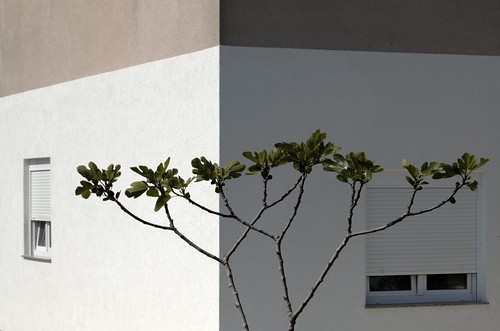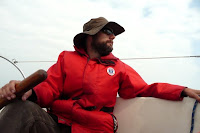
We had a wonderful harvest of our green figs this year; however, every year, we seem to have a second crop which absolutely never matures. It seems a shame to let them just drop off and rot, so I tried to find something to do with them. I'll tell you, it was a challenge. While I did find a couple of recipes (or thought I did), none of them provided me with actual, specific processing instructions, and that's a problem for figs (here are instructions for canning fresh,
ripe figs - you'll notice how long the boiling water bath processing takes with them).
Figs are not a highly acidic fruit, so you either have to acidify what you're preparing them for, or you have to pressure can them (I got reference for the pressure processing from a couple of different sources, including
Stocking Up, to use 5 lbs pressure for 10 minutes, but my pressure canning manual that came with my
weighted-gauge pressure canner doesn't recommend anything done at less than 10 lbs pressure). That's fine, but I didn't really have a positive idea of how long & at what pressure to process in the pressure canner. And how much lemon juice or vinegar do you need to add to acidify them sufficiently to just use the boiling water bath method? And really, who wants to process for 45-50 minutes in the boiling water when a pressure canner cuts the time enormously?
Not really knowing what to do, I sort of combined knowledge from a few different locations. My base recipe was from a
post by "
denninmi" on a
garden forum. But I added a signifcant amount of vinegar (roughly based on this
pickled green tomatoes recipe) to hopefully increase the acidity sufficiently.
Sikalaki Gliko2 pounds
unripe figs
3 pounds sugar
2 cups cider vinegar
1 cup water
1 lemon, seeded & diced fine
1/2 tsp cloves
1 tsp cinnamon
Rinse the figs and poke a hole in blossom end of each fig with a thick nail, a screwdriver or just a paring knife. This step is very messy from the sticky latex oozing out of the figs. I also pruned off the stems, but other recipes suggest to leave the stems intact (I suspect this is for
ripe figs only, but I'm not sure).
Place figs in water and let them soak for a few hours (I basically let them soak overnight). Discard the soaking water.
Boil the figs in plain water for 15 minutes.
Transfer figs into cold water, allow to cool down, then drain.
Replace cooking water with fresh water, and repeat the sequence of boiling the figs for 15 minutes, putting them in cold water until they’re cool, and then draining them.
I used a less than perfect aluminum pot (stainless steel is always recommend for preserving foods as it's non-reactive), because I didn't want to have an uncleanable, boiled-on latex mess on my wonderful stainless steel
maslin pan. Yes, the boiled latex came off with a significant amount of elbow grease and a scrubby pad.
Boil the 3 pounds of sugar with the vinegar and water for about 5 minutes, then add the figs, diced lemon and spices.
Boil the figs in the syrup for 30 minutes, then turn the heat off.
Leave the figs in the syrup for 12 hours.
Remove the figs from the syrup and boil the syrup until "thick" - I boiled the syrup to soft-ball stage (230F). This took a good hour of stirring and waiting.
Put the figs back in and bring back up to a boil so that the figs are hot and the syrup is boiling. I did this part in my maslin pan, which was perfectly shaped for this step, and by this point the latex had been boiled out of the figs.

Transfer the figs to clean, scalded half pint (250 mL) jars.
Squish the figs down so that the air is pushed out of the centres, and to pack the jar well. Don't pack the figs too tight; I did that and had to reprocess 5 of my 7 jars! And as a result of reprocessing, I had to make up a quick & dirty vinegar syrup to bring up the volume. Pour a little syrup to bring headspace up to 1/2" from rim. Run non-metal spatula around inside edge of jar to let air out, and adjust the headspace as necessary. Wipe rims with hot damp paper towel and apply two-piece metal snap & screw lids.
Now here's the tricky part. I couldn't find any concrete information about the processing time, so I placed the jars in my
weighted gauge pressure canner and processed at 10 lbs pressure for 10 minutes (remember that you have to vent the canner according to the manufacturer's instructions
before you place the weighted gauge on the vent, and timing for processing starts once the gauge starts to jiggle, indicating that the 10 lbs pressure has been reached).
I have to say that boiling the green figs is horribly stinky. I didn't enjoy that at all (about as pleasant-smelling, in my opinion, as boiling stinging nettle for
nettle beer; in fact, I thought the boiling figs was far worse than the stinging nettles, and that's saying something). But once you get the figs into the syrup and start to flavour them with sweet & spice, it seems much less unpleasant. I tried one of the figs today and while it's not sweet, exactly (the syrup is), and it doesn't taste like a fresh ripe fig, you can certainly get an essence of fig-ness from the flavour, as well as green-ness. It'll be really interesting to try it with stinky cheese and crackers; that's what I'd originally wanted to do this for. So, fingers crossed it was worth doing!!
And fingers crossed that I don't kill us all with botulism from under-processing the figs. But with the vinegar, and the increase pressure, I think (hope!) I've over-compensated.


































